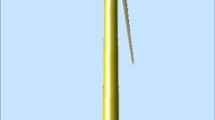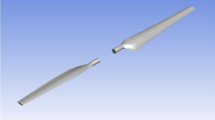Abstract
This paper proposes a novel approach for the implementation of limit controllers used for stall prevention and rotation speed limitation of a single-spool jet engine. In this approach, the protection requirements regarding the rotation speed are achieved through the use of a filter applied to the reference that will be sent to the power management controller of a Min–Max structure controller. The main controller variable is the turbine’s core rotation speed. The filter chooses the most appropriate reference value aiming at respecting the engine established limits, such as the stall margin and the maximum rotation speed, during transient and steady-state behaviors. The Min–Max compensators structure chosen for the implementation of the controllers is proportional–integral with Back Calculation as the anti-windup technique. Simulation model of a GE-J85-13 single-spool jet engine has been used to test the new approach and compare it to the more common Min–Max structure, where each controller is implemented individually. The simulation contemplates the case where a step function is applied to the power management controller, where the final value is the maximum allowed rotation speed value, at sea-level, static and standard-day temperature conditions. The simulation is repeated for different values of Back Calculation gains using both Min–Max structures, and the behavior of the GE-J85-13 engine is evaluated in each case for comparison proposes.

















Similar content being viewed by others
Abbreviations
- AS\((N_{c})\) :
-
Acceleration schedule vector
- AS\(_{N_{c}}^{\mathrm{Vec}}\) :
-
Acceleration schedule vector containing the maximum allowed variations for given values of \(N_{c}\)
- e :
-
Process error
- \(e_{\mathrm{I}}\) :
-
Integrator error
- EPR:
-
Engine pressure ratio
- \(e_\mathrm{ss}\) :
-
Steady value of PI compensator error
- \(F_\mathrm{n}\) :
-
Net thrust
- \(\mathrm{FR}_{\mathrm{N}}\) :
-
Rotation speed filtered reference
- I :
-
Moment of inertia of the engine’s rotating set
- \(K_{\mathrm{b}}\) :
-
Back Calculation constant
- \(K_{\mathrm{bN}}\) :
-
Back Calculation constant used on a rotation speed controller
- \(K_{\mathrm{bT}}\) :
-
Back Calculation constant used on a temperature controller
- \(K_{\mathrm{i}}\) :
-
Integrator term constant of a PI compensator
- \(K_{\mathrm{p}}\) :
-
Proportional term constant of a PI compensator
- N :
-
Shaft mechanical rotation speed
- \(N_{\mathrm{c}}\) :
-
Shaft corrected rotation speed
- \(N_{\mathrm{D}}\) :
-
Design point rotation speed
- \(N_{\mathrm{max}}\) :
-
Maximum allowed mechanical rotation speed
- \(N_{{ c}}^{\mathrm{Vec}}\) :
-
Vector containing \(N_{{c}}\) values and used in acceleration schedule
- PI:
-
Proportional–integral compensator
- \(P_{\mathrm{s}3}\) :
-
Combustion chamber static pressure
- \(P_{\mathrm{t}2}\) :
-
Compressor inlet total pressure
- \(P_{\mathrm{t}5}\) :
-
Turbine inlet total pressure
- \(\mathrm{PR}\) :
-
Compressor pressure ratio
- \(\mathrm{PR}_{\mathrm{stall}}\) :
-
Compressor pressure ratio for stall occurrence at a given \(N_{c}\)
- \(\mathrm{Ref}_{\mathrm{N}}\) :
-
Rotation speed desired reference
- \(\mathrm{RU}\) :
-
Ratio unit parameter
- \(\mathrm{RU}_{\mathrm{min}}\) :
-
Minimum value allowed for RU parameter
- \(\mathrm{SM}\) :
-
Stall margin
- \({t}_{\mathrm{s}}\) :
-
Settling time
- \(T_{\mathrm{s}}\) :
-
Sample Period
- \(T_{\mathrm{t}2}\) :
-
Compressor inlet total temperature
- \(T_{\mathrm{t}4}\) :
-
Turbine inlet temperature
- \(T_{\mathrm{t4max}}\) :
-
Maximum allowed TIT
- \(T_{\mathrm{t}5}\) :
-
Turbine exhaust temperature
- \(T_{\mathrm{std}}\) :
-
Standard-day temperature
- u :
-
Actuation signal calculated by PI compensator
- \(u_{0a}\) :
-
Initial steady value of actuation signal calculated by acceleration limit controller
- \(u_{0T_{\mathrm{t}4}}\) :
-
Initial steady value of actuation signal calculated by \(T_{\mathrm{t}4}\) limit controller;
- \(u_{0N}\) :
-
Initial steady value of actuation signal calculated by N limit controller
- \(u_{0\mathrm{pm}}\) :
-
Initial steady value of actuation signal calculated by power management controller
- \(u_{0\mathrm{r}}\) :
-
Initial steady value of real actuation signal
- \(u_{\mathrm{min}}\) :
-
Minimum allowed actuation signal
- \(u_{\mathrm{max}}\) :
-
Maximum allowed actuation signal
- \(u_{\mathrm{ss}}\) :
-
Steady value of actuation signal calculated by PI compensator
- \(u_{r}\) :
-
Actual control signal sent to engine’s fuel pump
- \(u_{\mathrm{rss}}\) :
-
Real actuation signal steady value
- \(W_{\mathrm{c}}\) :
-
Power demanded by the jet engine’s compressor
- \(w_{\mathrm{f}}\) :
-
Fuel mass flow
- \(W_{\mathrm{t}}\) :
-
Power delivered by the jet engine’s turbine
References
Bobula, G. A., & Burkardt, L. A. (1979). Effects of the steady-state pressure distortion on the stall-margin of a J85-21 turbojet engine. Technical Memorandum NASA TM-79123, NASA, NASA Lewis Research Center, Cleveland, OH 44135, USA. https://ntrs.nasa.gov/?R=19790015797. Accessed 12 Nov 2017.
Chappman, J., et al. (2014). Toolbox for the modeling and analysis of thermodynamic systems (T-MATS) user’s guide. Technical Memorandum NASA/TM-2014-216638, NASA, NASA Glenn Research Center, Cleveland, OH 44135, USA. https://ntrs.nasa.gov/search.jsp?R=20140012486. Accessed 27 Apr 2016.
Chapman, J. W., et al. (2016). Practical techniques for modeling gas turbine engine performance. In 52nd AIAA/SAE/ASEE joint propulsion conference, American Institute of Aeronautics and Astronautics. https://doi.org/10.2514/6.2016-4527.
Chapman, J. W., & Litt, J. S. (2017). Control design for an advanced geared turbofan engine. In 53rd AIAA/SAE/ASEE joint propulsion conference, American Institute of Aeronautics and Astronautics. https://doi.org/10.2514/6.2017-4820.
Csank, J., et al. (2010). Control design for a generic aircraft engine. In 46th AIAA/SAE/ASEE joint propulsion conference, American Institute of Aeronautics and Astronautics. https://doi.org/10.2514/6.2010-6629.
Hodel, A. S., & Hall, C. E. (2001). Variable-structure PID control to prevent integrator windup. IEEE Transactions on Industrial Electronics, 48(2), 442–451.
Imani, A., & Montazeri-Gh, M. (2017). Improvement of min–max limit protection in aircraft engine control: An lMI approach. Aerospace Science and Technology, 68, 214–222.
Jaw, L., & Mattingly, J. (2009). Aircraft engine controls: Design, system analysis and health monitoring. Chap 5–6 (pp. 119–170). Reston: American Institute of Aeronautics and Astronautics.
Johansson, M. (2003). Piecewise linear control systems (pp. 57–61). Berlin: Springer.
Kopasakis, G. (2010). Volume dynamics propulsion system modeling for supersonics vehicle research. ASME Journal of Turbomachinery, 132(4), 041003–041003-8. https://doi.org/10.1115/1.3192148.
Mehalic, C. M., & Lottig, R. A. (1974). Steady-state inlet temperature distortion effects on the stall limits of a J85-GE-13 turbojet engine. Technical Memorandum NASA TMX-2990, NASA Lewis Research Center, Cleveland, OH 44135, USA. https://ntrs.nasa.gov/search.jsp?R=19740009394. Accessed 12 Nov 2017.
Richter, H. (2012a). Advanced control of turbofan engines, chap 1 (pp. 1–4). New York: Springer.
Richter, H. (2012b). Multiple sliding modes with override logic: Limit management in aircraft engine controls. Journal of Guidance, Control and Dynamics, 35(4), 1132–1142.
Visioli, A. (2003). Modified anti-windup scheme for PID controllers. IEEE Proceedings: Control Theory and Applications, 150(1), 49–54.
Yarlagadda, S. (2010). Performance analysis of J85 turbojet engine matching thrust with reduced inlet pressure to the compressor. Master of science degree dissertation, The University of Toledo, Toledo, Spain.
Author information
Authors and Affiliations
Corresponding author
Rights and permissions
About this article
Cite this article
Neto, A.H., Yoneyama, T. A Novel Approach for Stall Prevention and Rotation Speed Limiting in a Min–Max Controller Structure. J Control Autom Electr Syst 30, 27–40 (2019). https://doi.org/10.1007/s40313-018-00424-z
Received:
Revised:
Accepted:
Published:
Issue Date:
DOI: https://doi.org/10.1007/s40313-018-00424-z




